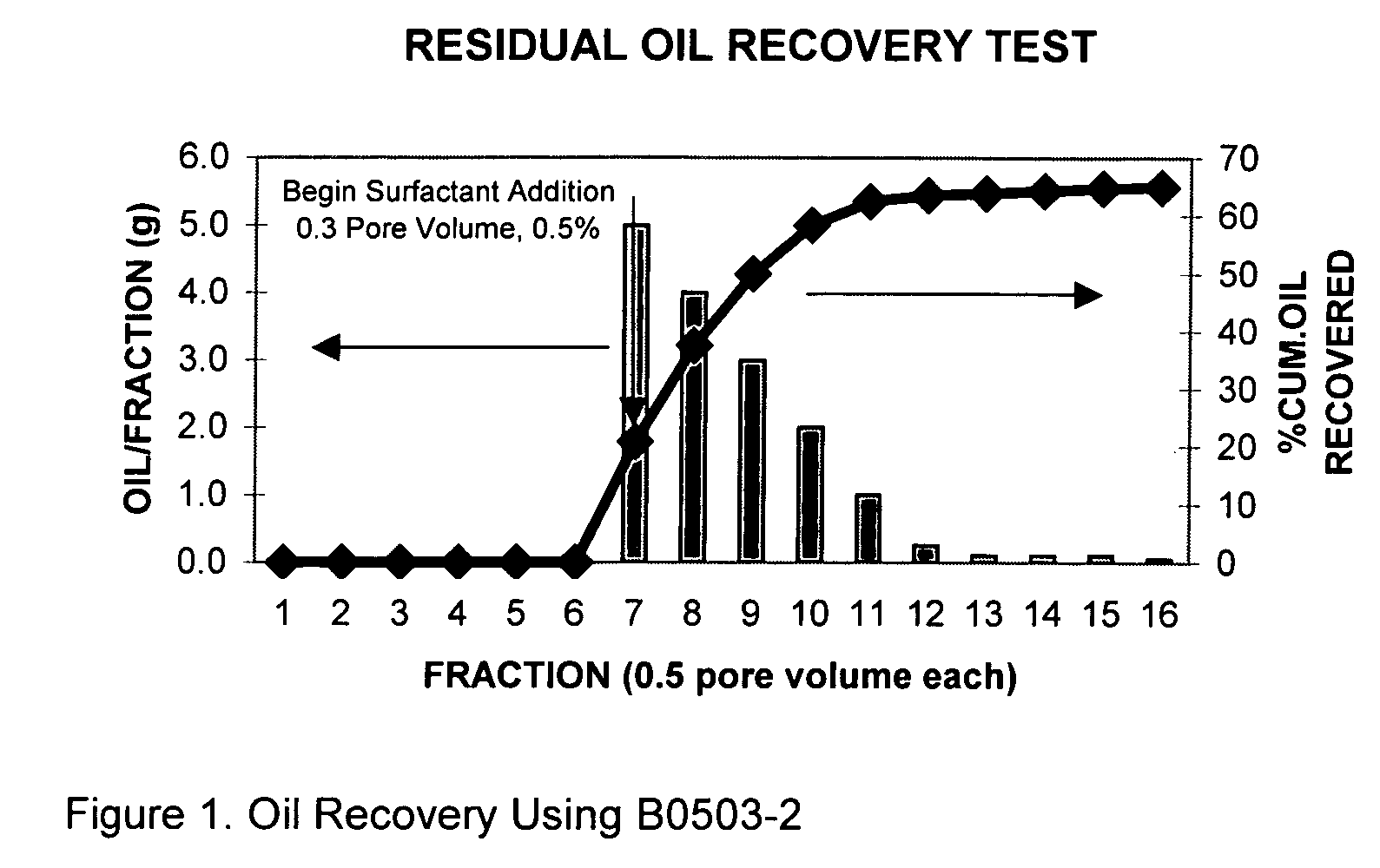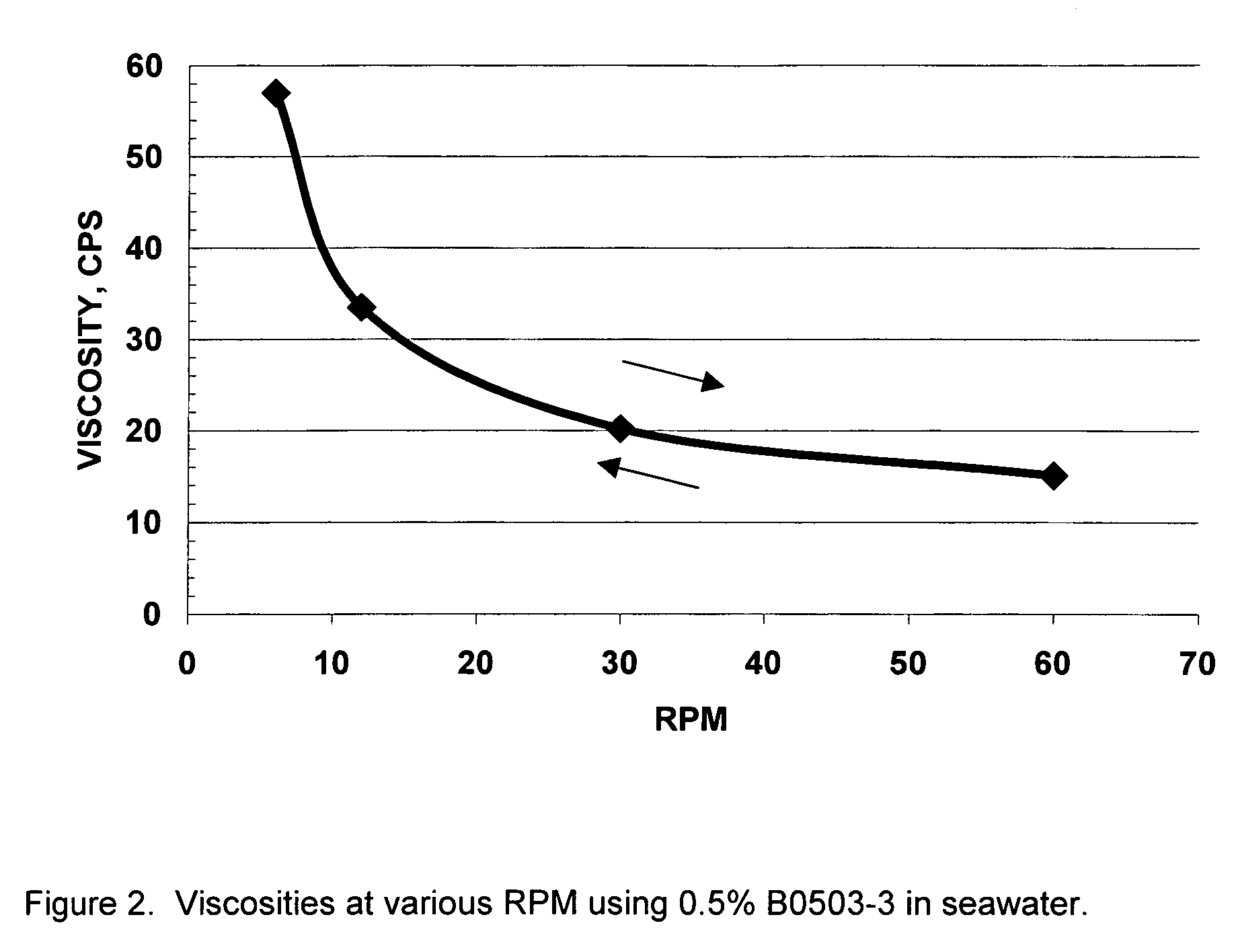Process for oil recovery employing surfactant gels
a technology of surfactant gel and oil recovery, which is applied in the direction of fluid removal, chemistry apparatus and processes, and wellbore/well accessories, etc., can solve the problems of serious formation damage, costly hydration unit for polymerization, and the eor process is not widely used in the industry, so as to increase the viscosity of injection brine
- Summary
- Abstract
- Description
- Claims
- Application Information
AI Technical Summary
Benefits of technology
Problems solved by technology
Method used
Image
Examples
example 1
[0037]This example illustrates the use of an amphoteric alkyl amido betaine surfactant derived from naturally occurring vegetable oils, to simultaneously lower the IFT of the brine / oil and increase the viscosity of the brine for an Asian oil field application.
[0038]The amphoteric surfactant, designated as B0503-1, was prepared by reacting 0.333 mole of soybean oil with 1.000 mole of dimethyl amino propyl amine (DMAPA). The resulting soya amidopropyldimethyl amine was further reacted with sodium chloroacetate in the presence of the proper amount of a 1:1 by weight mixture of water and butyl cellosolve to produce the soya amidopropyldimethyl betaine (sample no. B0503-1) with an active concentration of 50% by weight.
[0039]The brine from an Asian oil field, designated as Oil Field A, contained 32,000 ppm total dissolved solids, 1,850 ppm of the multivalent cations, and the crude oil had an API Gravity of 22. The bottom hole temperature was 60° C.
[0040]The IFT was measured using a Univer...
example 2
[0043]This example illustrates that B0503-1 from example 1 does not provide low IFT in Oil Field B—a west Texas Oil Field. This problem was resolved by adding an anionic surfactant along with the B0503-1 to give acceptable IFT and viscosity values.
[0044]The brine from the Field B contained 13,500 ppm total dissolved solids, 620 ppm multivalent cations and the crude oil had an API Gravity of 18. The bottom hole temperature was 48° C. B0503-2 was prepared by adding 1 part by weight of the sodium salt of C1416 arylalkyl xylene sulfonic acid, designated XSA-1416 and prepared as described-according to U.S. Pat. No. 6,043,391, to 10 parts by weight of B0503-1. As shown in Table 2, B0503-1 used alone did not provide low IFT and proper viscosity in the oil and brine from Oil Field B. However, by adding the anionic surfactant the IFT was lowered and the viscosity was increased.
[0045]
TABLE 2IFT and Viscosity Properties for Oil Field BB0503-1, 0.5%B0503-2, 0.5%IFT, mN / m0.0940.0085Visc @ 12 RPM...
example 3
[0046]This example illustrates the oil recovery obtained from columns packed with crushed core from Oil Field B.
[0047]Two separate but identical columns were prepared by adding 150 grams of the oil saturated crushed core from Oil Field B to glass chromatography columns 7 inches long and 1 inch in diameter. The oil saturated crushed core was prepared by mixing 16% by weight of the crude oil with 84% by weight of the crushed core. The columns were carefully prepared to eliminate air during packing. The Pore Volume (PV) of the columns was determined to be approximately 70% or 105 ml. This is the amount of liquid required for one displacement through the column. Each column contained 150 g×0.16=24 g oil. Injection field brine was passed through the bottom of each column and collected in fractions of approximately 0.5 PV (approximately 52.5 ml) each from the top. The brine was injected into the bottom of the columns until all the free oil was removed. Then an additional 3.5 PV of the bri...
PUM
| Property | Measurement | Unit |
|---|---|---|
| temperatures | aaaaa | aaaaa |
| hole temperature | aaaaa | aaaaa |
| temperature | aaaaa | aaaaa |
Abstract
Description
Claims
Application Information
 Login to View More
Login to View More - R&D
- Intellectual Property
- Life Sciences
- Materials
- Tech Scout
- Unparalleled Data Quality
- Higher Quality Content
- 60% Fewer Hallucinations
Browse by: Latest US Patents, China's latest patents, Technical Efficacy Thesaurus, Application Domain, Technology Topic, Popular Technical Reports.
© 2025 PatSnap. All rights reserved.Legal|Privacy policy|Modern Slavery Act Transparency Statement|Sitemap|About US| Contact US: help@patsnap.com



